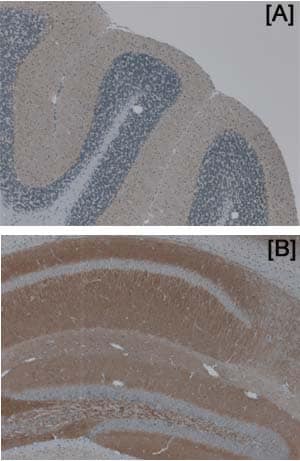Anti-PSD93 antibody (ab12097)
Key features and details
- Goat polyclonal to PSD93
- Suitable for: ICC/IF, IHC-P, WB
- Reacts with: Mouse, Human
- Isotype: IgG
Overview
-
Product name
Anti-PSD93 antibody
See all PSD93 primary antibodies -
Description
Goat polyclonal to PSD93 -
Host species
Goat -
Tested applications
Suitable for: ICC/IF, IHC-P, WBmore details -
Species reactivity
Reacts with: Mouse, Human
Predicted to work with: Rat
-
Immunogen
Synthetic peptide corresponding to Mouse PSD93 aa 1-100 conjugated to keyhole limpet haemocyanin.
(Peptide available asab12392) -
Positive control
- This antibody gave a positive result when used in the following formaldehyde fixed cell lines: SKNSH
-
General notes
PSD93 is part of the PSD-95/SAP90 family containing a modular structure with three PDZ-, one SH3- and a guanylate kinase-like domain. PSD93 is expressed in discrete neuronal populations as well as in specific non-neuronal cells. PSD93, like PSD-95, binds to NMDA receptors and to the neuronal nitric oxide synthase (NOS). PSD93 and PSD95 can heteromultimerize with each other and are recruited into the same NMDA receptor and K+ channel clusters. PSD93, however, is unique among PSD95/SAP90 family members in its expression in Purkinje neuron cell bodies and dendrites.
The Life Science industry has been in the grips of a reproducibility crisis for a number of years. Abcam is leading the way in addressing this with our range of recombinant monoclonal antibodies and knockout edited cell lines for gold-standard validation. Please check that this product meets your needs before purchasing.
If you have any questions, special requirements or concerns, please send us an inquiry and/or contact our Support team ahead of purchase. Recommended alternatives for this product can be found below, along with publications, customer reviews and Q&As
Properties
-
Form
Liquid -
Storage instructions
Shipped at 4°C. Upon delivery aliquot and store at -20°C or -80°C. Avoid repeated freeze / thaw cycles. -
Storage buffer
pH: 7.40
Preservative: 0.025% Sodium azide
Constituent: PBS -
 Concentration information loading...
Concentration information loading... -
Purity
Immunogen affinity purified -
Primary antibody notes
PSD93 is part of the PSD-95/SAP90 family containing a modular structure with three PDZ-, one SH3- and a guanylate kinase-like domain. PSD93 is expressed in discrete neuronal populations as well as in specific non-neuronal cells. PSD93, like PSD-95, binds to NMDA receptors and to the neuronal nitric oxide synthase (NOS). PSD93 and PSD95 can heteromultimerize with each other and are recruited into the same NMDA receptor and K+ channel clusters. PSD93, however, is unique among PSD95/SAP90 family members in its expression in Purkinje neuron cell bodies and dendrites. -
Clonality
Polyclonal -
Isotype
IgG -
Research areas
Images
-
ICC/IF image of ab12097 stained SKNSH cells. The cells were 4% formaldehyde fixed (10 min) and then incubated in 1%BSA / 10% normal donkey serum / 0.3M glycine in 0.1% PBS-Tween for 1h to permeabilise the cells and block non-specific protein-protein interactions. The cells were then incubated with the antibody ab12097 at 10µg/ml overnight at +4°C. The secondary antibody (pseudo-colored green) was Alexa Fluor® 488 donkey anti- goat (ab150133) IgG (H+L) preadsorbed, used at a 1/1000 dilution for 1h. Alexa Fluor® 594 WGA was used to label plasma membranes (pseudo-colored red) at a 1/200 dilution for 1h at room temperature. DAPI was used to stain the cell nuclei (pseudo-colored blue) at a concentration of 1.43µM for 1hour at room temperature.
-
 Immunohistochemistry (Formalin/PFA-fixed paraffin-embedded sections) - Anti-PSD93 antibody (ab12097)ab12097 PSD staining (10
Immunohistochemistry (Formalin/PFA-fixed paraffin-embedded sections) - Anti-PSD93 antibody (ab12097)ab12097 PSD staining (10µ µ -
 Immunohistochemistry (Formalin/PFA-fixed paraffin-embedded sections) - Anti-PSD93 antibody (ab12097) This image is courtesy of Chris Anderson, Wellcome Trust Sanger Institute, United Kingdomab12097 PSD staining (10
Immunohistochemistry (Formalin/PFA-fixed paraffin-embedded sections) - Anti-PSD93 antibody (ab12097) This image is courtesy of Chris Anderson, Wellcome Trust Sanger Institute, United Kingdomab12097 PSD staining (10µ g/ml) on mouse brain (5µ m sagittal section on slide; 4% PFA perfused & paraffin embedded). Granular staining observed as expected in [A] cerebellum and [B] hippocampus with ab12097. Blue=haemotoxylin nuclear counter-stain. Images taken with X10 objective.














